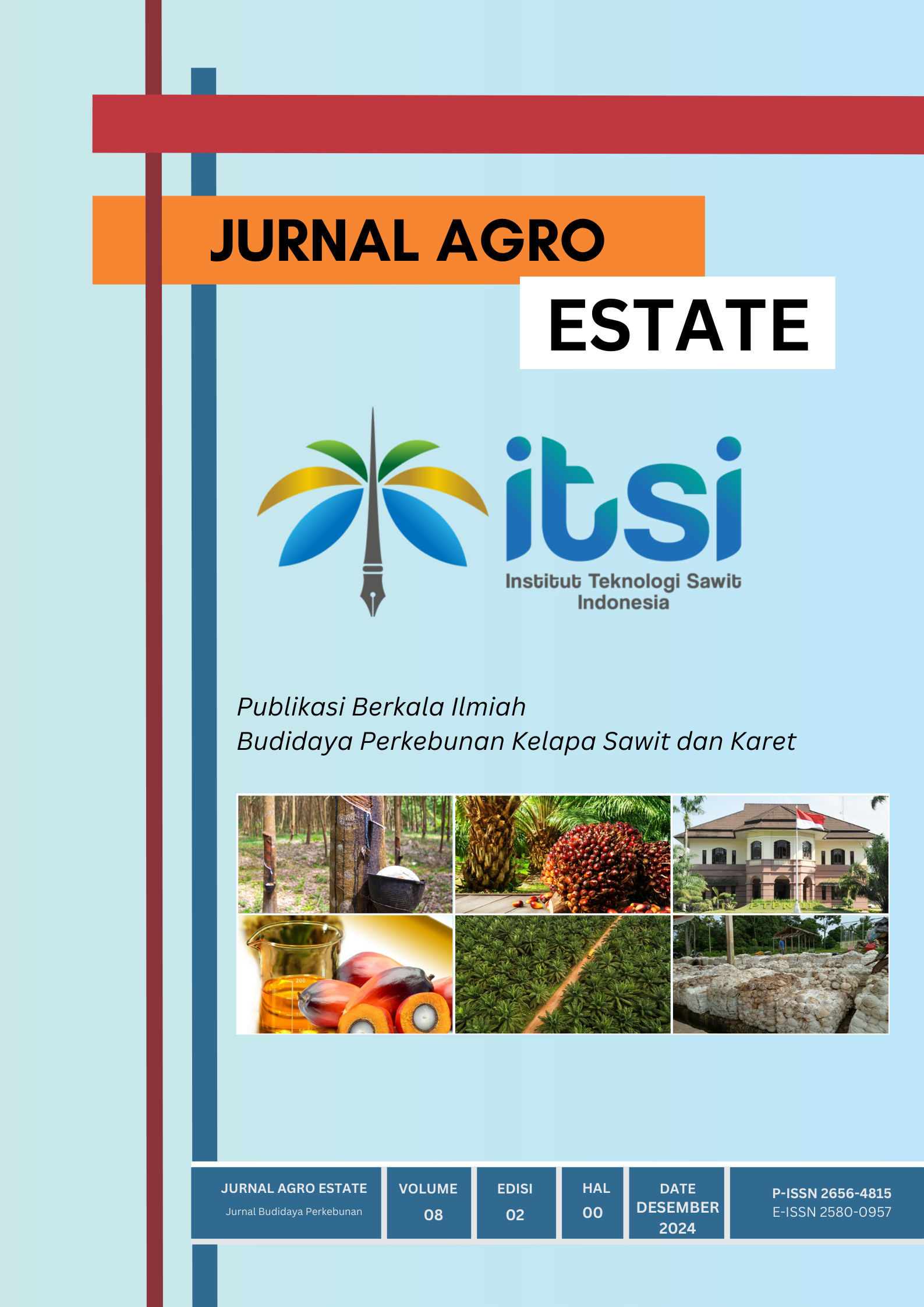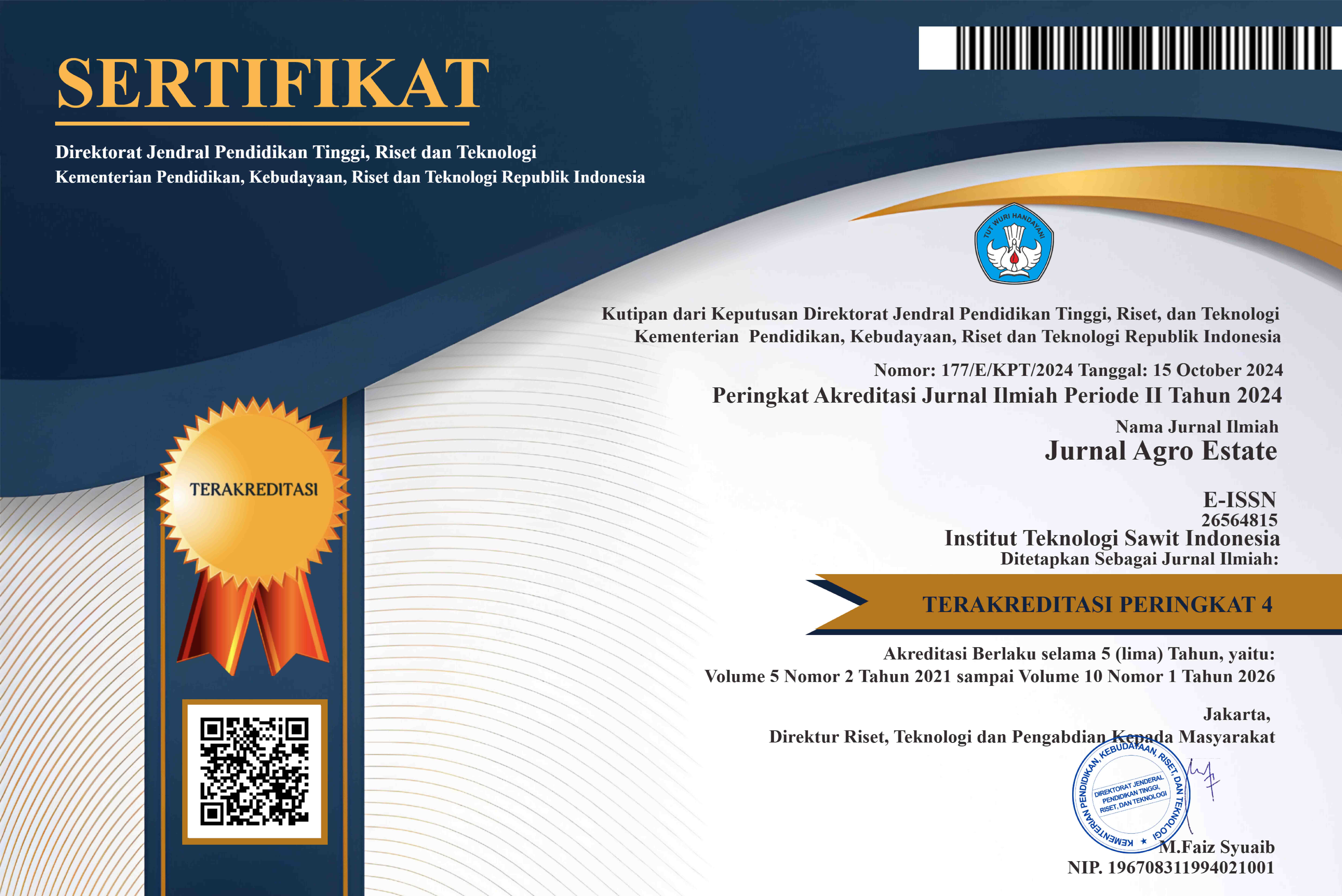The THE EFFECTS OF COMPOSTS AND NPK DOSAGE TO THE GROWTH OF OIL PALM (Elaeis guineensis Jacq) AT MAIN NURSERY
DOI:
https://doi.org/10.47199/jae.v8i2.262Keywords:
compost, empty palm oil bunches, recomendation dosage, rice straw, sawdustAbstract
One of the problems in nursery is difficulties to find topsoil and using of subsoil will be alternative. The objectives of this research were knowing the effects of kinds of compost, compound NPK dosage and interaction of them at oil palm in main nursery. Randomized block design was used with kinds of compost (J) and compound NPK dosage (D) as treatments; without compost (J1), rice straw compost (J2), sawdust compost (J3) and empty palm oil bunches compost (J4); without compund NPK (D0), ½ of recomendation compound NPK dosage (D1), ¾ of recomendation compound NPK dosage (D2) and ¾ of recommendation compound NPK dosage (D3); The research shows that height of plant at 6-12 weeks after planting, amount of leave at 10-12 weeks after plantings, stem diameter 7-12 weeks after planting, fresh weight of shoot and root at 12 weeks after plantings are significantly affected by kinds of compost (J). Heigh of plants at 6-12 weeks after plantings, stem diameter at 6-12 weeks after plantings, fresh and dry shoot weight at 12 weeks after planting are significantly affected by Compound NPK dosage. Heigh of plants at 7-12 weeks after planting, stem diameter 3-5 weeks after planting, dried roots weight at 12 weeks after planting are affected by interaction of kinds of compost and compound NPK dosage. J3 as compost from oil palm empty bunch; D3 as recommendation dosage compound NPK and K3D2 is better than the others.
Downloads
References
Harahap, F.S., Walida, H., Dalimunthe, B.A., Rauf, A., Sidabuke, S.H., Hasibuan, R., 2020. Penggunaan Kompos Sampah Kota dalam Upaya Merehabilitasi Tanah Sawah Terdegradasi di Desa Aras Kabu Kecamatan Beringin Kabupaten Deli Serdang. AGRINULA: Jurnal Agroteknologi dan Perkebunan 3. https://doi.org/10.36490/agri.v3i1.85
Idawati, I., Rosnina, R., Jabal, J., Sapareng, S., Yasmin, Y., Yasin, S.M., 2017. Penilaian Kualitas Kompos Jerami Padi dan Peranan Biodekomposer Dalam Pengomposan. Journal TABARO Agriculture Science 1. https://doi.org/10.35914/tabaro.v1i2.30
Kurnianingsih, A., Susilawati, Sefrila, M., 2019. Karakter Pertumbuhan Tanaman Bawang Merah Pada Berbagai Komposisi Media Tanam. Jurnal Hortikultura Indonesia 9. https://doi.org/10.29244/jhi.9.3.167-173
Moh Nisban Ramli, 2022. Pengomposan Tandan Kosong Kelapa Sawit (Elaeis guineensis) dengan Beberapa Pemberian mikroorganisme lokal (MOL). Arview 1, 27–37.
Pahan, I. 2015. Panduan Teknis Budidaya Kelapa Sawit untuk Praktisi Perkebunan. Penebar Swadaya, Jakarta.
Pasaribu, A.I., Wicaksono, K.P., 2019. Pengaruh Komposisi Media Tanam Terhadap Pertumbuhan Bibit Kelapa Sawit (Elaeis guineensis Jacq.) Tahap Pre Nursery. Jurnal Produksi Tanaman 7.
Rosa, R.N., Zaman, S., 2017. Pengelolaan Pembibitan Tanaman Kelapa Sawit (Elaeis guineensis Jacq.) Di Kebun Bangun Bandar, Sumatera Utara. Buletin Agrohorti 5. https://doi.org/10.29244/agrob.v5i3.16470
Salman, N., 2022. Potensi Serbuk Gergaji Sebagai Bahan Pupuk Kompos. Jurnal Komposit 4. https://doi.org/10.32832/komposit.v4i1.3695
Widarti, B.N., Kasran, R.F., Sarwono, E., 2016. Pengaruh Ukuran Bahan Terhadap Kompos Pada Pemanfaatan Tandan Kosong Kelapa Sawit. Jukung (Jurnal Teknik Lingkungan) 1. https://doi.org/10.20527/jukung.v1i1.1034
Downloads
Published
How to Cite
Issue
Section
License
Copyright (c) 2024 Jurnal Agro Estate

This work is licensed under a Creative Commons Attribution-ShareAlike 4.0 International License.























